 Figure 1. Processing the first and all four trials from a set of repeat CMJ.
Figure 1. Processing the first and all four trials from a set of repeat CMJ.
Integration drift is a fancy way of saying that if you complete more than one jump without saving the test, you will save data that is inflated (most likely). The video below shows the difference and explains why:
The Hawkin Dynamics Way
In the Hawkin Dynamics Cloud Software, you complete one Countermovement Jump and then save it. We understand that this differs from other companies that allow multiple tests under one data collection. However, our research team has evaluated and continually evaluates this protocol and has found it to be unreliable. The first CMJ output will be okay as long as a quiet standing phase is first gathered (for at least 1.0 second). If the athlete completes the next 2-?? tests without completely coming to a standstill between reps, then these test metrics will become significantly inflated on the second, third, fourth test, and so on. This is called Integration Drift, and a full review of this concept can be found here. Dr. Jason Lake is one of the world's most renowned force plate biomechanists. He is currently a professor at Chichester University (UK).
A Video Of What NOT To Do & What Some Others Suggest:
-
Notice that the athlete is not coming to a standstill between jumps. A Quiet Standing period is vital to accurately calculate System Weight (i.e. the athlete's weight in Newtons) in order to accurately collect the metrics that follow.
-
The athlete is also moving his feet around between jumps. We call this 'happy feet' and this will also throw off your System Weight.
By allowing an athlete to move around on the force plates, jump multiple times back to back without holding still for at least 1 second, and pass the jump - subsequent data will be inflated due to integration drift. That is data that is not reliable. If you use this data and compare, you are comparing faulty data and data that is not truly representative of that athlete due to data collection errors.
At Hawkin Dynamics, we have standards in place to limit data collection errors. Before each and every test, there is a quiet standing period. If the athlete fails to stand still, the test won't start. We care about data integrity and providing you with the best possible information and solutions to make decisions in your day-to-day.
Interested In Learning More?
Download the CMJ Playbook to learn everything you need to know about the CMJ and how to accurately perform the test.
What is the impact of different testing surfaces? Read more here!
Editor's Note: This post was originally published in October 2021 and has been revamped and updated for accuracy and comprehensiveness.
-1.png?width=290&name=HawkinRocket%20(1)-1.png)
-2.png?width=156&height=60&name=Hawkin%20Logo%20(2)-2.png)
-1.png?width=155&height=60&name=WHITE.Horizontal_Logo.Transparent%20(3)-1.png)



